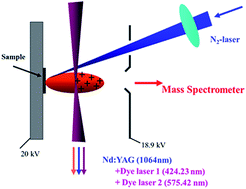A laser ablation resonance ionisation mass spectrometer (LA-RIMS) for the detection of isotope ratios of uranium at ultra-trace concentrations from solid particles and solutions
Abstract
A commercial MALDI-TOF mass spectrometer has been combined with a tunable ns-pulse laser ionisation system consisting of two dye lasers pumped by the second (532 nm) and the third (355 nm) harmonics of a Nd:YAG laser. Uranium samples in the form of solutions, suspensions or small solid grains can be placed onto an aluminium substrate without the MALDI matrix from which they are desorbed by a 337 nm nitrogen laser with a spatial resolution of ∼20 μm. A rapid and simple sample preparation process not involving any chemical separation, pre-concentration or need for chemical derivatisation reactions is employed. The neutral uranium atoms and molecules are resonantly ionised by the photoionisation system. Highly selective and efficient uranium photoionisation schemes have been developed. They are three-colour, two-step photoionisation schemes involving resonance excitation from the ground state by a 424.23 nm laser (∼1 μJ per pulse) and subsequently by either 578.48 nm, 575.42 nm or 574.10 nm lasers (∼20 μJ per pulse) with 1064 nm (>1 mJ) ionisation into the continuum. Three-colour excitation, targeting specific uranium atomic levels, allows for selective ionisation of uranium atoms. The photo-ions have the yields of up to two orders of magnitude higher than those formed in laser desorption making them extremely suitable for the detection of isotope ratios of samples with trace concentrations. A series of measurements of reference materials with concentrations between 1010 and 1016 atoms per sample (10−15 to 10−7 g) and various isotope compositions ranging from depleted and natural to enriched uranium positively confirm the method applicability. For instance, for the samples of depleted uranium the 235U/238U < 0.003 ratio was determined with <7% precision (2σ errors) for the total uranium concentrations not exceeding ∼80 fg per sample.



 Please wait while we load your content...
Please wait while we load your content...